81242
Poly(ethylene glycol)
tested according to Ph. Eur., 4,000
Synonym(s):
Macrogol 4,000, Polyethylene glycol, PEG
Sign Into View Organizational & Contract Pricing
All Photos(1)
About This Item
Linear Formula:
H(OCH2CH2)nOH
CAS Number:
MDL number:
UNSPSC Code:
12352104
PubChem Substance ID:
NACRES:
NA.21
Recommended Products
Agency
tested according to Ph. Eur.
Quality Level
form
solid
mol wt
3500-4500
application(s)
pharmaceutical (small molecule)
SMILES string
C(CO)O
InChI
1S/C2H6O2/c3-1-2-4/h3-4H,1-2H2
InChI key
LYCAIKOWRPUZTN-UHFFFAOYSA-N
Looking for similar products? Visit Product Comparison Guide
Related Categories
General description
Poly(ethylene glycol) (PEG) is a non-toxic water-soluble polymer. PEG term is used for the polymer chains with molecular weights below 20 000, while poly(ethylene oxide) (PEO) refers to the higher molecular weight polymers. PEG has various biomedical applications. It forms complexes with α-cyclodextrins. Engineering of PEG hydrogel particles by mesoporous silica (MS) templating method has been reported.
Application
Poly(ethylene glycol) may be used in the following studies:
- For the modification of proteins to form the conjugates having increased circulating life and reduced immunogenicity and antigenicity.
- Preparation of hydrogels useful for the diffusion controlled delivery of proteins.
- Preparation of poly(ethylene glycol) dimethacrylate (PEGDM).
Storage Class Code
11 - Combustible Solids
WGK
WGK 1
Flash Point(F)
Not applicable
Flash Point(C)
Not applicable
Personal Protective Equipment
dust mask type N95 (US), Eyeshields, Gloves
Choose from one of the most recent versions:
Already Own This Product?
Find documentation for the products that you have recently purchased in the Document Library.
Customers Also Viewed
The clinical efficacy of poly (ethylene glycol)-modified proteins.
Fuertges F and Abuchowski A.
Journal of Controlled Release : Official Journal of the Controlled Release Society, 11(1), 139-148 (1990)
Stephanie J Bryant et al.
Annals of biomedical engineering, 32(3), 407-417 (2004-04-21)
In approaches to tissue engineer articular cartilage, an important consideration for in situ forming cell carriers is the impact of mechanical loading on the cell composite structure and function. Photopolymerized hydrogel scaffolds based on poly(ethylene glycol) (PEG) may be synthesized
Complex formation between poly (ethylene glycol) and α-cyclodextrin.
Harada A and Kamachi M.
Macromolecules, 23(10), 2821-2823 (1990)
N A Peppas et al.
Journal of controlled release : official journal of the Controlled Release Society, 62(1-2), 81-87 (1999-10-16)
The use of hydrogels as carriers for protein delivery has been a subject of significant recent research. In our recent work, we have shown that diffusion controlled delivery of proteins from hydrogels containing poly(ethylene glycol) (PEG) can be possible and
I L Konorova et al.
Patologicheskaia fiziologiia i eksperimental'naia terapiia, (4)(4), 7-9 (1991-07-01)
The search for antiaggregatory compounds is undertaken, as a rule, under in vitro conditions which do not reflect the dynamics of the real process. The present work deals with study of the peculiarities of the development of the collagen induced
Our team of scientists has experience in all areas of research including Life Science, Material Science, Chemical Synthesis, Chromatography, Analytical and many others.
Contact Technical Service


